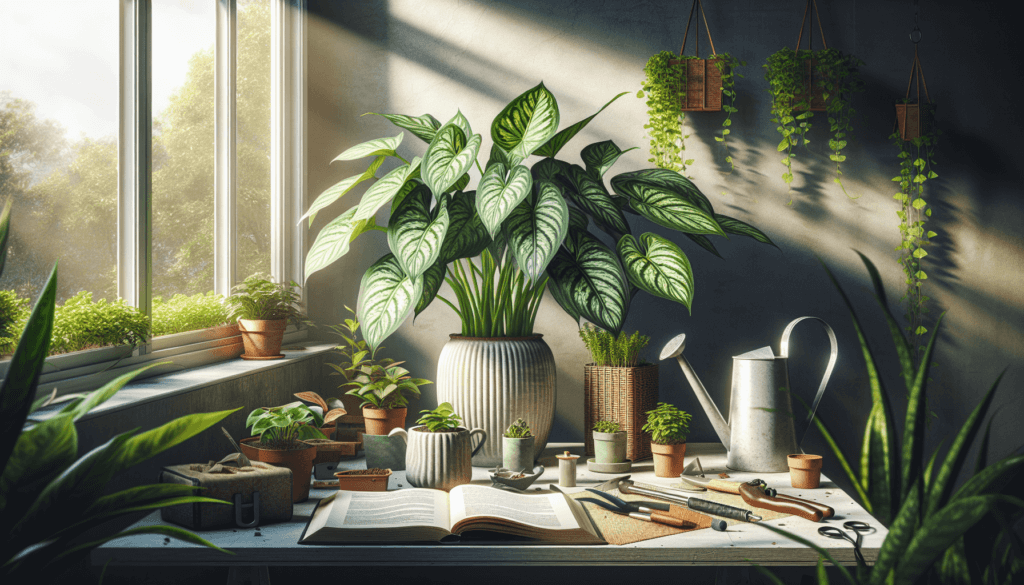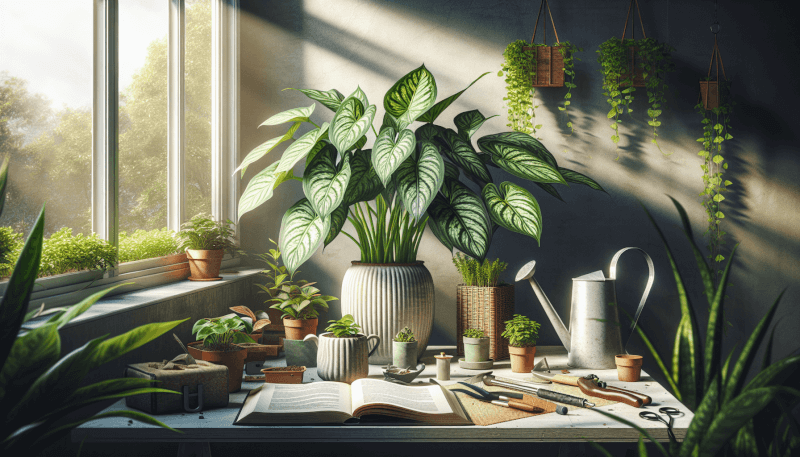Interested in adding a touch of green to your space? Look no further than Syngonium plants. With their vibrant foliage and low-maintenance nature, these plants are the perfect addition to any indoor garden. From providing a pop of color to improving air quality, Syngoniums have it all. Whether you’re a seasoned plant parent or just starting your gardening journey, this article will provide you with all the essential care tips you need to keep your Syngonium thriving and flourishing. So, let’s dive into the world of Syngonium plant care and bring some natural beauty into your life.

Watering
Frequency
Proper watering is essential for the health of your Syngonium plant. As a general rule, you should water your plant when the top inch of soil feels dry to the touch. Depending on the temperature and humidity levels in your home, this could mean watering your plant once or twice a week. However, it’s important to remember that every environment is different, so you should always check the moisture level of the soil before watering.
Watering Method
When it comes to watering your Syngonium, it’s best to use the bottom-up method. Simply place your plant in a tray filled with water and allow the soil to soak up the moisture through the drainage holes in the pot. This method ensures that the roots receive adequate hydration without the risk of waterlogging or overwatering. After 15-20 minutes, remove the plant from the tray and allow any excess water to drain away.
Watering Signs
To determine if your Syngonium needs watering, pay attention to its leaves. If they begin to droop or wilt, it’s a clear indication that your plant is thirsty. Additionally, if the leaves start turning yellow or brown, it can be a sign of overwatering or poor drainage. Always assess the soil moisture level and adjust your watering schedule accordingly to prevent any watering issues.
Lighting
Ideal Light Conditions
Syngonium plants thrive in bright, indirect light. Ideally, place your plant near a north or east-facing window where it will receive plenty of bright but filtered sunlight. The leaves of the Syngonium are sensitive to direct sunlight, so avoid placing the plant in direct sunlight as it can lead to scorched or burned leaves. If your home doesn’t have an adequately bright spot, you can supplement the light with a grow light to ensure your Syngonium gets the necessary light it needs for healthy growth.
Avoid Direct Sunlight
While Syngonium plants love bright light, direct sunlight can be harmful to their delicate foliage. Direct sunlight can lead to leaf scorching or burning, causing unsightly brown spots or patches on the leaves. It’s important to carefully monitor the location of your Syngonium plant and ensure that it is shielded from direct sunlight, especially during the peak hours of the day. By providing your plant with the right amount of bright but indirect light, you will help it thrive and maintain its beauty.
Temperature
Ideal Temperature Range
Syngonium plants prefer temperatures that mimic their native tropical habitat. Ideally, keep your plant in an environment with temperatures ranging between 60°F to 85°F (15°C to 29°C). These plants are not tolerant of extreme temperature fluctuations, so it’s important to ensure consistent temperatures within this range. Avoid placing your Syngonium in areas with drafts or near air conditioning units or heaters, as these can cause temperature fluctuations that may stress the plant.
Avoid Drafts
Drafts can have a detrimental effect on the overall health of your Syngonium plant. Sudden changes in temperature caused by drafts can lead to leaf discoloration, wilting, and even plant stress. To prevent this, keep your plant away from windows or doors where cold or hot air can enter, and avoid placing it near air vents or fans. By providing a stable and draft-free environment, you will help your Syngonium thrive and maintain its vibrant foliage.
Humidity
Optimal Humidity Levels
Being native to tropical regions, Syngonium plants appreciate higher humidity levels. Ideally, maintain humidity levels between 50% to 60% for optimal growth. If the humidity in your home is lower, especially during dry winter months or in air-conditioned environments, you can increase humidity levels around your plant by using a humidifier, placing a tray of water nearby, or grouping your Syngonium with other plants to create a microclimate with higher humidity.
Misting and Pebble Trays
Misting is a popular method to increase humidity levels for houseplants, and Syngoniums are no exception. Lightly misting the leaves of your Syngonium plant with room temperature water can help mimic the humid conditions it thrives in. Additionally, you can create a DIY humidity tray by placing a tray filled with water and pebbles near your plant. As the water evaporates, it increases the humidity around your Syngonium. Remember to refill the tray regularly to maintain proper humidity levels.

Soil
Well-Draining Soil
Syngonium plants require well-draining soil to prevent waterlogging and root rot. A good potting mix for Syngoniums consists of a blend of regular potting soil, perlite, and peat moss. This combination provides the right balance of moisture retention and excellent drainage, allowing the roots to breathe and prevent the soil from becoming overly saturated. Avoid using heavy or clay-like soils, as they tend to retain too much moisture and can lead to root issues.
Use of Peat Moss or Perlite
Adding peat moss or perlite to the potting mix can greatly enhance the drainage and aeration of the soil. Peat moss helps retain moisture while still allowing excess water to drain, while perlite is a lightweight additive that improves soil structure and prevents compaction. Aim for a potting mix that is well-balanced and provides the right environment for your Syngonium’s root system, promoting healthy growth and overall plant vitality.
Fertilizing
Frequency of Fertilization
To keep your Syngonium plant healthy and thriving, it’s important to fertilize it regularly. During the active growing season, which is typically spring and summer, fertilize your plant every two to four weeks. Dilute a balanced houseplant fertilizer to half the recommended strength and apply it to the soil. It’s important not to over-fertilize, as this can lead to fertilizer burn or a buildup of salts in the soil. During the dormant period in winter, reduce the frequency of fertilization to once every two months.
Use of Balanced Houseplant Fertilizer
Syngonium plants benefit from a balanced houseplant fertilizer that provides essential nutrients for their growth. Look for a fertilizer with equal or balanced ratios of nitrogen (N), phosphorus (P), and potassium (K), such as a 10-10-10 or 20-20-20 formulation. These nutrients promote overall plant health, strong foliage, and encourage robust growth. Always follow the instructions on the fertilizer packaging and adjust the dosage based on your specific plant’s needs.
Pruning and Training
Trimming Dead or Yellow Leaves
Regular pruning is essential for maintaining the health and aesthetics of your Syngonium plant. Remove any dead, yellow, or damaged leaves to prevent the spread of diseases and pests. Use clean, sharp pruning shears or scissors to make clean cuts just above the node or stem junction. This will encourage new growth and help your Syngonium maintain its lush appearance.
Encouraging Bushier Growth
If you desire a fuller and bushier Syngonium plant, you can promote branching and denser growth through pruning and training techniques. Pinch or trim the tips of the stems to encourage lateral branching, which will result in a more compact and bushy plant. Additionally, you can train your Syngonium to climb or trail by providing a trellis or moss pole for support. Regularly prune and shape the plant to maintain the desired form and promote healthy growth.
Repotting
Frequency of Repotting
Syngonium plants do not require frequent repotting, but it’s important to monitor their growth and make adjustments as needed. Generally, repotting every one to two years, or when the root system has outgrown the current pot, is sufficient. Repotting in the spring is ideal, as it allows the plant to recover and establish itself during the active growing season. Remember to choose a pot that is slightly larger than the current one to provide ample room for the roots to expand.
Choosing the Right Pot and Soil
When selecting a new pot for your Syngonium plant, opt for one with drainage holes to prevent waterlogging. A pot made of terracotta or a porous material allows for better airflow and drainage. Ensure the pot is slightly larger than the current one to allow the roots to grow and establish. Remember to use a well-draining potting mix as discussed earlier to provide the appropriate soil environment for your Syngonium’s root system.
Pest Control
Common Pests
While Syngonium plants are generally resistant to pests, there are a few common ones to be aware of. Spider mites, aphids, and mealybugs can occasionally infest your plant. These pests can cause stunted growth, yellowing leaves, and overall decline in plant health. Regularly inspect your Syngonium for any signs of pests, such as webbing, sticky residue, or small crawling insects. Early detection is key to preventing a full-blown infestation.
Using Organic Pest Control Methods
If you notice signs of pests on your Syngonium, prompt action is necessary. To control infestations, you can use organic pest control methods, such as spraying the plant with a solution of neem oil and water. Neem oil is known for its insecticidal properties and can effectively combat a variety of pests. Additionally, wiping down the leaves regularly with a mild soap and water solution can help remove any pests and keep your Syngonium clean and healthy.
Propagation
Propagation Methods
If you wish to propagate your Syngonium and create more plants, there are a few methods you can try. One common method is stem cutting propagation. Simply take a stem cutting just below a node, remove the lower leaves, and place the cutting in a jar or vase with water. After a few weeks, roots will begin to develop, and you can transfer the cutting into a pot with well-draining soil.
Another propagation method is by division, which involves separating the plant into two or more sections. Carefully remove the plant from its pot, gently separate the root clumps or rhizomes, and replant each section into its own pot with fresh potting soil. Make sure each division has adequate roots and foliage to ensure successful growth.
Caring for New Cuttings
Once you have propagated your Syngonium and have new cuttings or divisions, it’s important to provide them with proper care. Place the cuttings in a warm and bright location, but avoid direct sunlight. Keep the soil moist but not overly saturated, as this can lead to rotting. Monitor the new plants closely and ensure they receive the same care and conditions as established Syngoniums. With time and care, your new cuttings will thrive and grow into mature, beautiful Syngonium plants.


